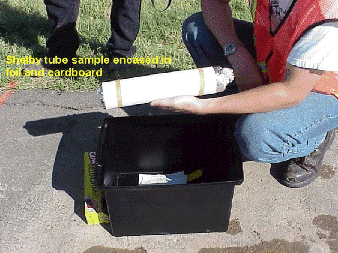5.5 Shelby Tube
Shelby tube samples have been used to determine the in situ density, moisture content, plasticity index (PI), potential vertical rise (PVR), sulfate content, optimum soil stabilizer, and modulus of the subgrade soil. Samples acquired through this procedure are often termed “undisturbed.”
The Shelby tube is a sharpened pipe that is pushed into soil by a hydraulic ram on a truck-mounted boom. These tubes are too fragile to be driven thorough any layer other than unbound fine grained soils. An auger can be used to remove the HMA and base layers, allowing collection of Shelby tube samples without introducing water in the process. After the HMA and base layers are removed, the Shelby tube is positioned on the subgrade and pushed roughly 2 ft. (0.6 m) into the soil, as shown in Figure 4-24. The pipe is then pulled out and placed on a rack. A hydraulic ram then pushes the soil out of the pipe in (hopefully) one cylindrical piece. Aluminum foil and cardboard tubes are used to protect the Shelby tube samples, as shown in Figure 4-25. The tube is labeled with information, including the location, orientation, and depth of the sample.
If deeper samples are desired, the Shelby tube can be extended and pushed into the bottom of the same hole. That sample is then labeled as coming from a lower depth at the same location as the first. In this way, several samples can be collected at any location, then pieced together later for a complete soil profile.

Figure 4-24. Extracting subgrade samples with Shelby tube.

Figure 4-25. Aluminum foil/cardboard tube to protect Shelby tube samples.